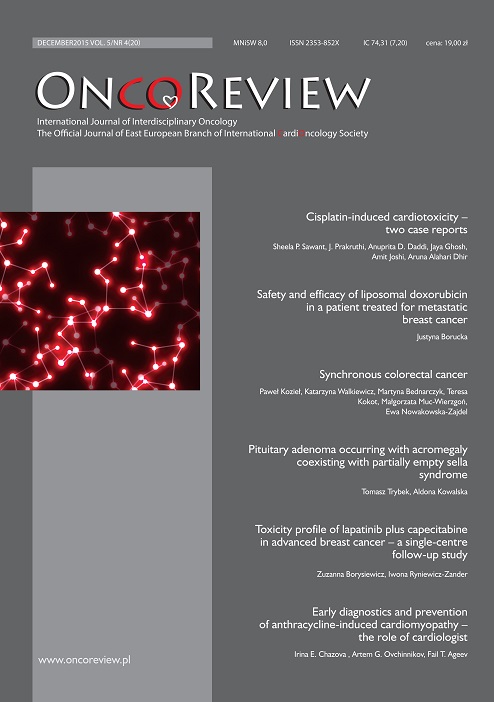Kardiotoksyczność indukowana cisplatyną – prezentacja dwóch przypadków Case report
##plugins.themes.bootstrap3.article.main##
Abstrakt
Cisplatyna od ponad 40 lat znajduje zastosowanie w chemioterapii różnych nowotworów. Toksyczność indukowana opartymi na niej schematami terapeutycznymi to przede wszystkim: toksyczność przewodu pokarmowego, toksyczność szpiku, neurotoksyczność, ototoksyczność oraz nefrotoksyczność. Chemioterapia oparta na cisplatynie kojarzona jest ponadto z szeroką gamą powikłań sercowo-naczyniowych. W niniejszej pracy przedstawiono 2 przypadki kardiotoksyczności indukowanej cisplatyną. Przedstawiamy przypadki 2 młodych pacjentów, u których doszło do ostrego zawału mięśnia sercowego podczas skojarzonej chemioterapii z zastosowaniem bleomycyny, etopozydu oraz cisplatyny. W pierwszym przypadku doszło do ostrego zawału mięśnia sercowego ściany przedniej z uniesieniem odcinka ST, a w drugim – do ostrego zawału mięśnia sercowego z obwodowymi tętniczymi powikłaniami zakrzepowo-zatorowymi. Cisplatyna może indukować zdarzenia sercowo-naczyniowe. Klinicyści powinni z dużą ostrożnością postępować z pacjentami poddawanymi chemioterapii opartej na cisplatynie. Wczesne rozpoznanie kardiotoksyczności pozwala podjąć interwencję w odpowiednim czasie i zapobiec trwałemu uszkodzeniu serca.
Pobrania
##plugins.generic.paperbuzz.metrics##
##plugins.themes.bootstrap3.article.details##

Utwór dostępny jest na licencji Creative Commons Uznanie autorstwa – Użycie niekomercyjne 4.0 Międzynarodowe.
Copyright: © Medical Education sp. z o.o. This is an Open Access article distributed under the terms of the Attribution-NonCommercial 4.0 International (CC BY-NC 4.0). License (https://creativecommons.org/licenses/by-nc/4.0/), allowing third parties to copy and redistribute the material in any medium or format and to remix, transform, and build upon the material, provided the original work is properly cited and states its license.
Address reprint requests to: Medical Education, Marcin Kuźma (marcin.kuzma@mededu.pl)
Bibliografia
2. Rosenberg B, Van Camp L, Krigas T. Inhibition of cell division in Escherichia coli by electrolysis products from a platinum electrode. Nature 1965; 205: 698.
3. Reed E. Cisplatin, Carboplatin and Oxaliplatin. In: Chabner BA, Longo DL (ed.). Cancer chemotherapy and biotherapy – principles and practice. Lippincott Williams & Wilkins, Philadelphia 2006: 332.
4. Wang D, Lippard SJ. Cellular processing of platinum anticancer drugs. Nat Rev Drug Discov 2005; 4: 307-320.
5. El-Awady el-SE, Moustafa YM, Abo-Elmatty DM, Radwan A. Cisplatin-induced cardiotoxicity: Mechanisms and cardioprotective strategies. Eur J Pharmacol 2011; 650: 335-341.
6. Kintzel PE. Anticancer drug-induced kidney disorders. Drug Saf 2001; 24: 19-38.
7. Patanè S. Cardiotoxicity: cisplatin and long term cancer survivors. Int J Cardiol 2014; 175(1): 201-202.
8. Al-Majed AA, Sayed-Ahmed MM, Al-Yahya AA et al. Propionyl-L-carnitine prevents the progression of cisplatin induced cardiomyopathy in a carnitine-depleted rat model. Pharmacol Res 2006; 53: 278-286.
9. Schimmel KJ, Richel DJ, van den Brink RB et al. Cardiotoxicity of cytotoxic drugs. Cancer Treat Rev 2004; 30(2): 181-191.
10. Sen F, Karavelioglu Y, Yildiz I et al. Multiple arterial occlusions precipitated by platinum based chemotherapy in a patient with testicular seminoma. Journal-CVS 2014; 2(1): 10-12.
11. Moore R, Adel N, Riedel E et al. High Incidence of Thromboembolic Events in patients treated With Cisplatin Based Chemotherapy: A Large Retrospective Analysis. J Clin Oncol 2011; 29: 3466-3473.
12. Martín GG, Fernández SP, Castro VS et al. Vertebral Artery Occlusion after Chemotherapy. Stroke 2008; 39: e38.
13. Tassinari D, Sartori S, Drudi G et al. Cardiac arrhythmias after cisplatin infusion: Three case reports and a review of the literature. Ann Oncol 1997; 8: 1263-1267.
14. Waseem R, Hussain M, Imtiyaz D et al. Cisplatin induced paroxysmal supraventricular tachycardia. Indian J Med Paediatr Oncol 2013; 34(4): 330-332.
15. Khan S, Chen C, Brady MS et al. Unstable Angina associated With Cisplatin and Carboplatin in a patient With Advanced Melanoma. J Clin Oncol 2012; 30(18): e163-e164.
16. Heit JA, Silverstein MD, Mohr DN et al. Risk factors for deep vein thrombosis and pulmonary embolism: A population-based case-control study. Arch Intern Med 2000; 160: 809-815.
17. Haugnes H, Wethal T, Aass N et al. Cardiovascular Risk Factors and Morbidity in Long-Term survivors of Testicular Cancer: A 20-Year Follow-Up Study. J Clin Oncol 2010; 28(30): 4649-4657.
18. Czaykowski PM, Moore MJ, Tannock IF. High risk of vascular events in patients with urothelial transitional cell carcinoma treated with cisplatin based chemotherapy. J Urol 1998; 160: 2021-2024.
19. Shoji S, Miyakita H, Shima M et al. Acute myocardial infarction during combined chemotherapy with bleomycin, etoposide and cisplatin for testicular cancer. Acta Urol 2006; 52: 723-726.
20. Lee YG, Lee E, Kim I et al. Cisplatin based chemotherapy is a strong risk factor for thromboembolic events in small-cell lung cancer. Cancer Res Treat 2015; 47(4): 670-675.
21. Seng S, Liu Z, Chiu SK et al. Risk of venous thromboembolism in patients with cancer treated with Cisplatin: a systematic review and meta-analysis. J Clin Oncol 2012; 30: 4416-426.
22. Nuver J, Smit AJ, van der Meer J et al. Acute chemotherapy-induced cardiovascular changes in patients with testicular cancer. J Clin Oncol 2005; 23: 9130-9137.
23. Lajer H, Daugaard G. Cisplatin and hypomagnesemia. Cancer Treat Rev 1999; 25: 47-58.
24. Turlapaty PD, Altura BM. Magnesium deficiency produces spasms of coronary arteries, relationship to etiology of sudden death ischemic heart disease. Science 1980; 208: 198-200.
25. Dieckmann K, Struss W, Budde U. Evidence for Acute Vascular Toxicity of Cisplatin-based Chemotherapy in Patients with Germ Cell Tumor. Anticancer Research 2011; 31: 4501-4506.
26. Kawano N, Yamaguchi K, Niki T et al. Two cases of acute myocardial infarction during combined chemotherapy in young patients with testicular cancer. J Cardiol Cases 2013; 7: e176-e180.
27. Yang Z, Schumaker LM, Egorin MJ et al. Cisplatin preferentially binds mitochondrial DNA and voltage dependent anionchannel protein in the mitochondrial membrane of head and neck squamous cellcarcinoma: possible role in apoptosis. Clin Cancer Res 2006; 12: 5817-5825.

